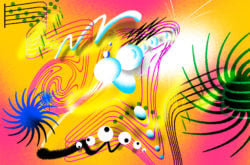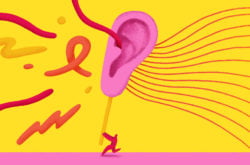Illustration: Jeremy Leung
Information and data are all around us these days, but have you ever stopped to think if they could be made into music?
Sonification—or the representation of data using sound—is usually meant to help us gain some additional insight beyond what a visualization alone might show. However, we can also take this raw information and get even more creative to achieve some truly unique musical experiences.
Tunes from the brain
One of the earliest examples of artistic sonificiation, or music based in data, comes from the mind of avant-garde American composer Alvin Lucier. His 1965 experimental piece titled “Music for Solo Performer” starts with a single ‘performer’ hooked up to an EEG (electroencephalogram) device, which measures electrical brain activity. The resulting brain waves are then used to trigger an ensemble of different percussion instruments.
While there’s a mixing assistant behind the scenes who helps translate these incoming brain signals into music, the piece is great at making us more aware of the things that may be happening beyond the scope of our human senses—with sonification being a great tool for accomplishing just that.
The sounds of space
It’s pretty ironic that astronomical data has been such a popular catalyst for music creation, since there’s literally no sound in the endless vacuum of space—but you’ll quickly find there’s no shortage of celestial sonification out there.
Wayne Grim’s “233rd Day” was performed over three hours during the 2017 full solar eclipse (featuring the Kronos Quartet for about 30 minutes), with the music being generated from a live feed of the eclipse itself. “The First 4000 Exoplanets,” composed by SYSTEM Sounds, is another especially soothing way to experience humanity’s discovery of planets outside our solar system. The pitch of each piano note comes from the relative orbital period of that planet, while the volume of the note is determined by how many similar planets were discovered at around the same point in time. The soft pad sound, on the other hand, is guided by color data of stars from the Milky Way. You can check out the SYSTEM Sounds website for more stunning space-based sonifications, and they’ve also worked with scientists from Harvard and NASA on some image-based pieces too.
Data as an aesthetic
Data is becoming increasingly intertwined with the artistic process, sometimes to the point where it becomes the central subject. Composers like Ryoji Ikeda are exploring ways in which data can become its own fully-immersive sensory experience through both image and sound. His project ‘superposition’ is about “the way we understand the reality of nature on an atomic scale” and presents “sound, visuals, physical phenomena, mathematical concepts, human behavior, and randomness” all at the same time in a state of superposition.
There’s a definite theme here around the pure aesthetics of data, and how all this information can make us feel more inspired and “alive” when presented in a playful and new way, rather than as just a bunch of numbers on a screen.
From fireworks to spiderwebs, digital technology has made it possible to translate pretty much anything into sound. Have you encountered any music that draws directly from data? Let us know in the comments!
Explore royalty-free one-shots, loops, FX, MIDI, and presets from leading artists, producers, and sound designers:
December 14, 2021



